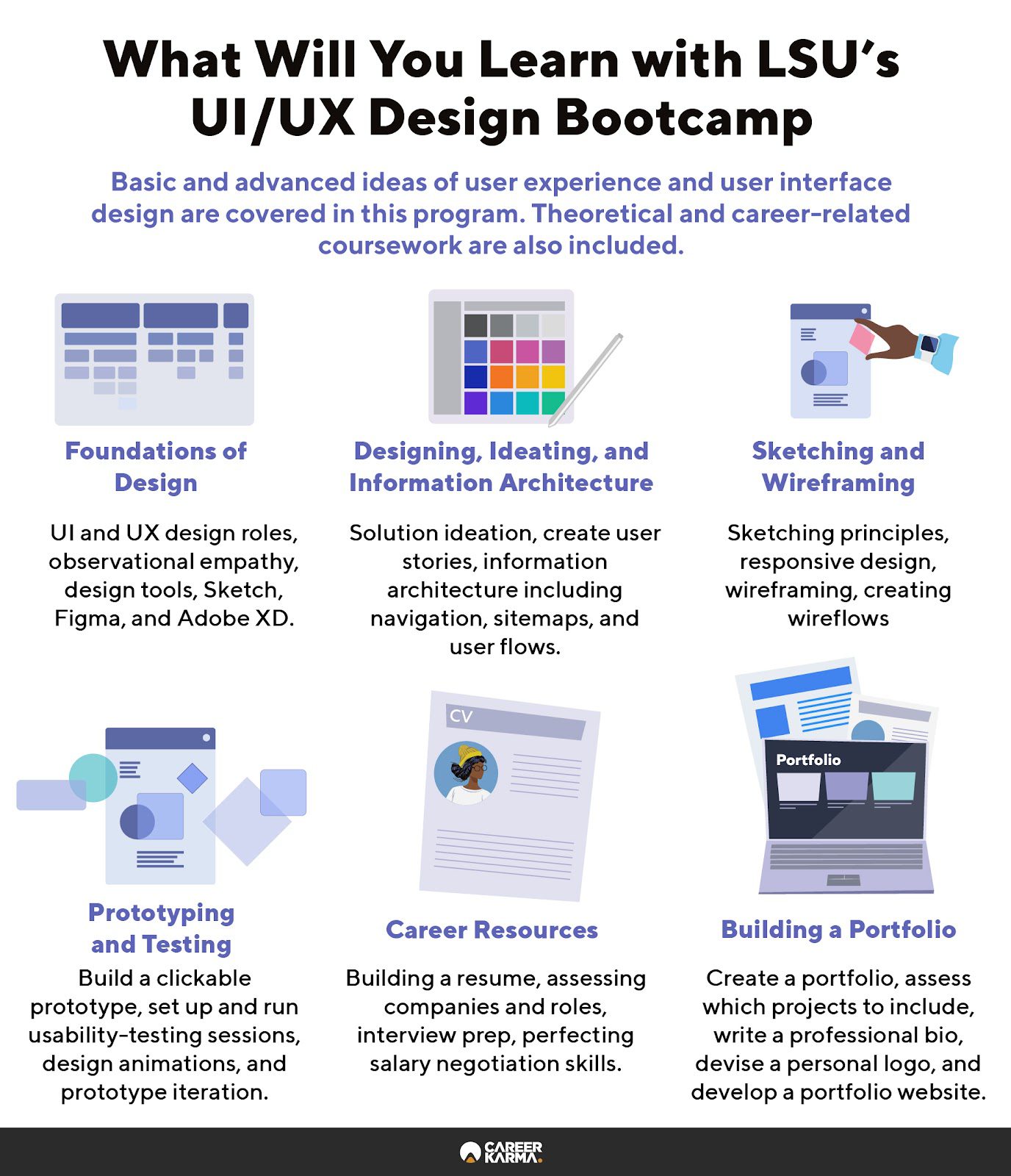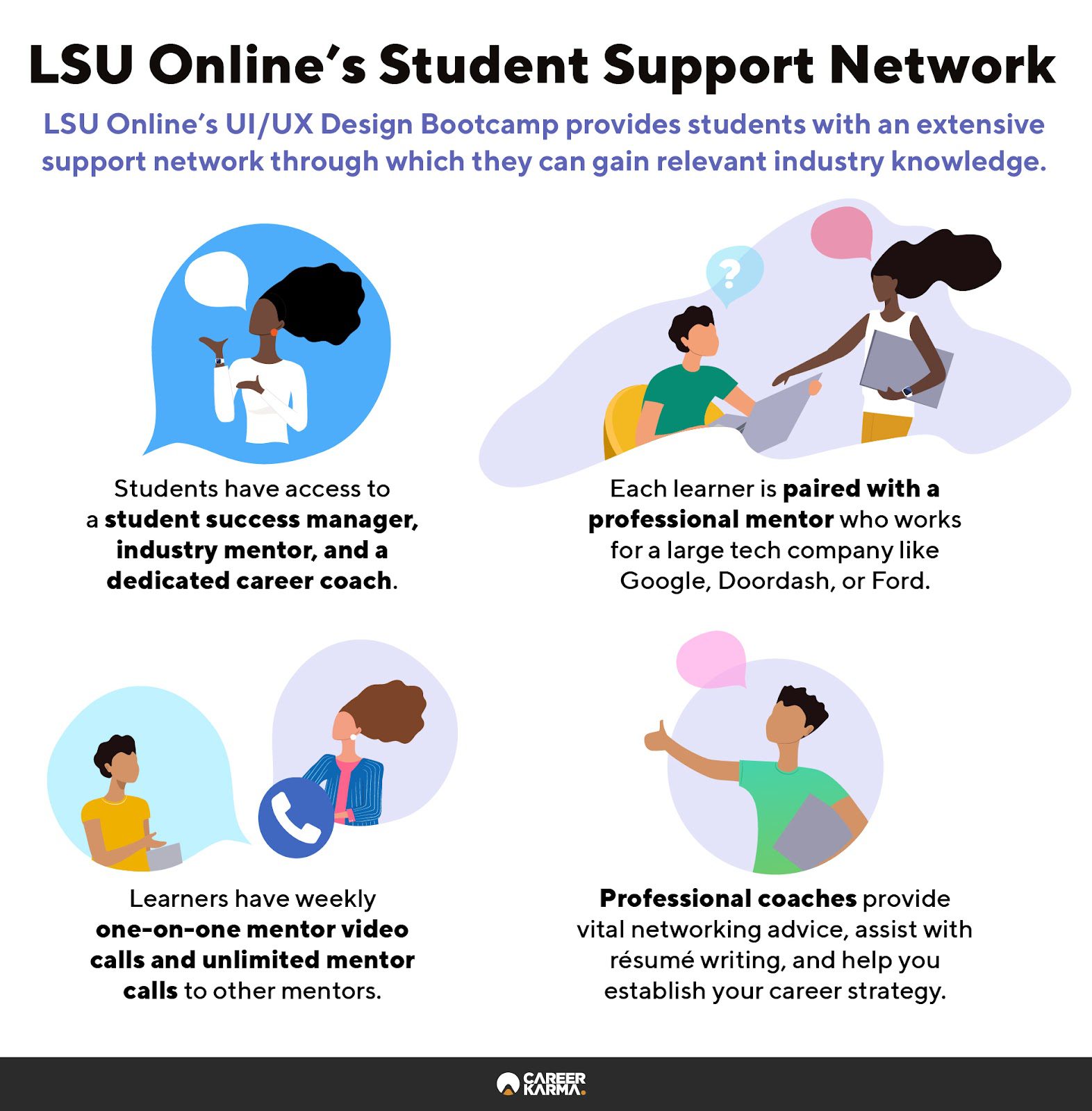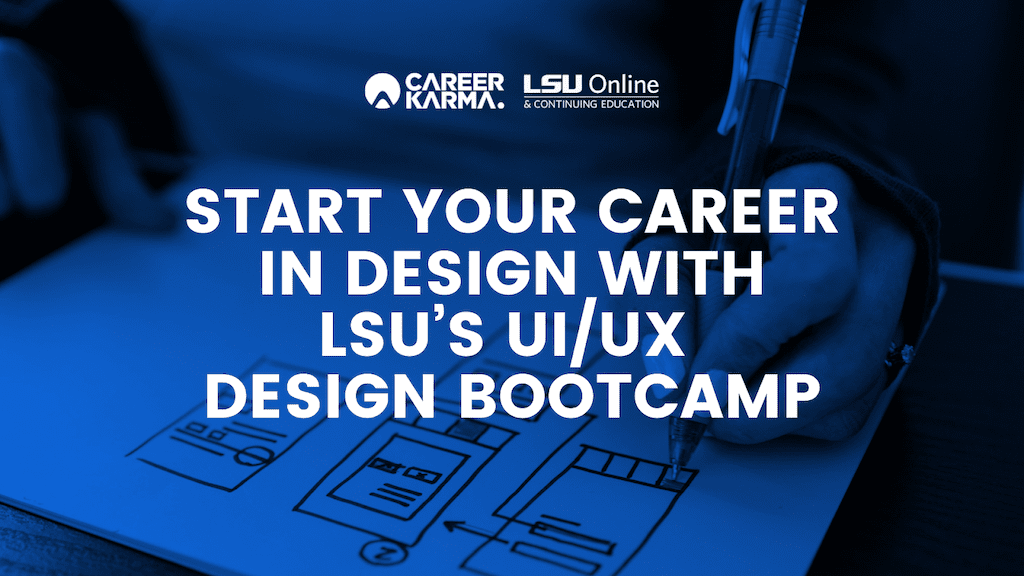For most businesses, the primary goal is to boost sales. In the digital world, an increase in sales largely depends on how satisfied a customer is when they use a website, product, app, or service. The more satisfactory their experience is, the higher chances of them being converted from a visitor to a buyer.
Customer satisfaction is primarily determined by how user-friendly and intuitive an app or website is, which boils down to a strong user interface and user experience design. As more companies realize the value of design, UI and UX designers are emerging as one of the most sought-after professionals in today’s digital economy.
If you want to start a new career in UI and UX design, consider Louisiana State University’s new online UI/UX Design Bootcamp.
A career in design is within your reach with LSU’s new online UI/UX Design Bootcamp which covers crucial topics that can round out your design repertoire.
Learn more about LSU Online’s UI/UX Design Bootcamp here.Louisiana State University’s UI/UX Design Bootcamp

LSU Online now offers a UI/UX Design Bootcamp where students learn design skills directly from industry experts. The program teaches foundational and advanced UI/UX skills, such as core design principles, implementing design tools, and learning about best practices.
You’ll also have access to a variety of design industry tools, receive hands-on training and mentorship, conduct research, complete projects, and receive one-on-one mentoring. By the end of the program, you’ll graduate with a portfolio that demonstrates your skills to potential employers.
Who Should Take LSU’s UI/UX Design Bootcamp?
If you have strong visual and communication skills, the UI/UX design bootcamp is an ideal course for you. The program is open to everyone, which means that you don’t need any prior experience or background in design to qualify.
The bootcamp takes nine months on average to complete, with learners expected to spend at least 10 hours a week on the course. This makes it an ideal choice for parents and working professionals who have to juggle other commitments and responsibilities along with their studies.
Note that you can also finish the program earlier if you spend more time every week completing course requirements.
What Will You Learn from LSU’s UI/UX Design Bootcamp?
LSU’s UI/UX Design Bootcamp covers basic and advanced concepts of user experience and user interface design. Several modules in the UI/UX design bootcamp include resources that incorporate both theory and career-related coursework. They also include design exercises that mimic real-world applications.
LSU’s UI/UX design bootcamp covers the following modules:
Foundations of Design
This module includes the essential stages of design thinking. Learners learn the roles and key traits of UI and UX designers. Topics include UI and UX design roles, observational empathy, and design tools, such as Sketch, Figma, and Adobe XD.
Conducting Research
Through research, students learn to identify problems and familiarize themselves with the user for whom they are fixing the problem. This module will cover multiple UX research types and plans, teach learners how to recruit users and carry out interviews, and ways to present research to clients.
Designing, Ideating, and Information Architecture
The main goal of this module is to help you make the right design decisions and tackle any design problems that may arise. You’ll focus on user stories and use information architecture best practices to adjust your product based on how your user moves through and interacts with it. Topics covered include solution ideation, creating user stories, and information architecture including navigation, sitemaps, and user flows.
Foundations of UI Design
This module teaches students essential design techniques that every UI designer should know, such as visual and UI principles, and how to develop design systems and style guides. In this module, learners go through various UI activities and begin to build their UI design toolbox. They also create distinct style guides that focus on the visual impact and language of their projects.
Sketching and Wireframing
If you want to make high-fidelity designs, you must first develop low-fidelity design sketches. Sketching is a simple way to put all your great ideas onto paper to help you identify the areas you need to improve. Once your sketches are ready, the next step is to develop wireframes, which are computerized representations of your sketches.
High-Fidelity Design
After learning how to create style guides and wireframes, students move on to making high-fidelity mockups of what they designed. They also focus on polishing their style guide and developing animations that are consistent with their brand platform. In this module, students learn inclusive design, designing for accessibility, defining their grid, and designing efficiently with tools.
Prototyping and Testing
These are essential tools that help identify problems and validate design decisions. During this module, learners develop a clickable prototype and learn how to set up and run usability-testing sessions, which include performing various tasks and determining whether they need to make adjustments to their original design. Topics include building a prototype, designing animations, and prototype iteration.
Communication Best Practices
UI/UX designers work closely with developers, team members, and key stakeholders. Designers must know how to cooperate with others. This module focuses on communication skills, such as collaborating and communicating with developers, preparing for handing off designs, creating a case study, and the components of an effective presentation.
Special Topics
Beyond learning the essential analytical skills of UI/UX design, the course also investigates the foundational skills a UI/UX designer must possess, and which specialized skills are highly valued by hiring managers. This module includes best practices and solutions in product types, the psychology of design, and the business of UX.
Career Resources
After completing the main part of the UI/UX design bootcamp, students have the option to participate in the Career Resources module, which lasts approximately 35 hours. This is designed to help learners create a job search strategy that is based on their specific professional goals.
Students learn how to build their resumes, evaluate companies and roles, go through interview prep, and successfully practice their salary negotiation skills to land their dream jobs. Participants also work closely with a career coach to help them reach their goals.
Building a Portfolio
Getting a job in the UI/UX industry requires a work-ready portfolio. It allows graduates to showcase their skills and display their competence to potential employers. The UI/UX design bootcamp teaches students how to put together a portfolio that contains all of the projects they worked on and finished throughout the course.
Graduates learn how to choose which projects to include and which to leave out to produce a compelling and comprehensive collection of their work. They also learn how to write a professional bio, design a personal logo, and develop their own portfolio website.
UI Portfolio
Students are expected to spend a significant part of their time practicing the skills they learned using industry-standard tools. UI exercises are integrated into the course, ensuring that learners build their visual skills and understand how to evaluate and improve their designs.
End to End Projects
Throughout the course, students have the option to create and complete four projects to include in their portfolios. The first capstone project is compulsory, and the other three portfolio projects are optional. These optional projects include a second capstone project, a design sprint, and an Industry Design Project.
The design sprint employs active design methodologies to address business needs. Learners will be expected to swiftly design, prototype, and test their ideas to answer crucial business questions.
The Industry Design Project is optional but highly recommended because proficiency in various UI/UX design tools is essential if you want to work in this industry. Moreover, real-world experience is vital in the job search of ambitious UI/UX designers.
LSU collaborates with several companies and accelerator programs that students will work with on their Industry Design Project. Learners will be asked for their opinions and assistance in the development of new products and the enhancement of existing ones.
Through this project, students gain exposure to the industry and gain learning experience while collaborating with design teams composed of fellow bootcamp learners or clients. They also have the opportunity to go deeper into particular aspects of the UI/U design process.
What Support Can You Expect from the Bootcamp?

Although the program is 100 percent online and self-paced, students receive full human support throughout the program. They have access to a student success manager, industry mentor, and a dedicated career coach to help them with job interviews.
Each learner is matched with an industry mentor thoroughly vetted by the program’s application process. LSU only accepts one in 12 mentor applicants. Mentors work for large tech companies, such as Google, Doordash, and Ford. They provide learners with project support and crucial industry insight.
Learners have weekly one-on-one mentor video calls and have access to unlimited mentor calls to other mentors in the community. They are also part of a vibrant online community with fellow members of their cohort.
Career coaches are also available to help graduates during their job search. They give valuable tips about networking, help build resumes, and define your career strategy.
How Much Is LSU’s UI/UX Design Bootcamp?
LSU’s UI/UX Design Bootcamp costs $12,555 when paid upfront. You can also opt to pay only for the months you need through monthly payments of $1,550 for up to nine months. LSU also offers other tuition payment options, such as a Climb Credit loan and tuition assistance with Campus Federal.
Why Choose LSU’s UI/UX Design Bootcamp?
UI/UX designer is a well-paid, fast-growing occupation in the US and the demand for UX and UI designers continues to increase. LSU’s UI/UX Design Bootcamp aims to help prospective graduates successfully land their first UI/UX design job and start a new career path.
Aside from the in-demand skills that you’ll learn in the program, the prestige that comes from attending Louisiana’s flagship university and the state’s highest-rated public school, is also a vital asset that will help you stand out among other applicants during your job search.
To learn more about this online program, visit LSU’s UI/UX Design Bootcamp page here.
About us: Career Karma is a platform designed to help job seekers find, research, and connect with job training programs to advance their careers. Learn about the CK publication.




